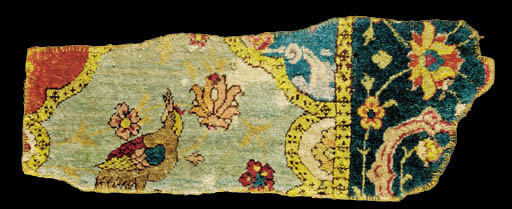|
A FRAGMENT OF THE "HATVANY" SAFAVID FIGURAL CARPET
SECOND QUARTER 16TH CENTURY
Price Realized £12,925 ($18,547)
Sale Information
Christie's SALE 6435
ORIENTAL RUGS AND CARPETS
3 May 2001
London, King Street
LOT NOTES
Lot Description
A FRAGMENT OF THE "HATVANY" FIGURAL CARPET
Safavid Persia, second quarter 16th Century
The light blue field with a bird and flowers together with part of a
medallion, in a medium blue border of flowers, small areas of repiling,
otherwise full pile, 8in. x 1ft.5in. (20cm. x 43cm.)
Provenance: Dikran K Kelekian
John Schorscher, Toronto
with the Textile Gallery, London
Literature: Cselenyi, Ladislav: Oriental Rugs from the Collection of Mr John
Schorscher, Toronto, 1972, additional page at end
Exhibited: Royal Ontario Museum, 1972
Lot Notes
This beautiful small fragment comes from the main border of what must once
have been one of the most beautiful carpets ever woven. Larger fragments
of the border are in the Brooklyn Museum, which have recently been
separated from another fragment from the same carpet depicting houris
(Erdmann, Kurt: Seven Hundred Years of Oriental Carpets, London, 1970,
fig.220). The most notable part of the whole carpet is the central
medallion, part of which was in the collection of Baron Hatvany in Budapest
and which was last seen during the second world war (Pope, Arthur Upham: A
Survey of Persian Art, Oxford, 1938, pl.1141). A further fragment from the
carpet entered the Musée des Tissues, Lyon in 1900 (Bennett, Ian: "Splendours
of the City of Silk, part 2, Ten Safavid Masterpieces", Hali 33,
January-March 1987, p.40). The present piece adjoins the Lyon fragment.
There has been considerable variance on the attibution of a weaving centre
for this carpet. Pope suggested Tabriz which Erdmann concurred with. Bennett
suggested Kashan or Isfahan for the Lyon example, while East Persia was
suggested by Cselenyi when this piece was published. Charles Grant Ellis
suggested Herat for the Brooklyn fragments, also suggesting that they came
from more than one carpet ("Some compartment designs for Carpets, and Herat"
Textile Museum Journal, Vol.1, no.4, 1965), while Donald King, quoting Ellis
and Erdmann, sat on the fence for the Hayward Gallery exhibition, quoting
"North-West or East Persia" (The Eastern Carpet in the Western World,
exhibition catalogue, London, 1983, no.63, p.89).
It is made with a very soft wool which has more of the touch of the wool
used in central Persian carpets than that normally associated with Tabriz.
And if one follows the generally accepted theory that the "Herat" carpets
were made in Isfahan, then there is no other place in Eastern Persia which
could have been the centre for the manufacture. The drawing on the Hatvany
fragment shows it to have been made during the reign of Shah Tahmasp; the
turbans are of a type which went out of fashion in 1560. Qazvin would have
been the capital of the country at this time and may very well be the city
of manufacture, as suggested in passing by Erdmann. Wherever it was made, it
is a remarkable and gorgeous fragment, a survival from what must have been
an astoundingly beautiful carpet.
 |

